Stanford submits initial plans for future Belmont campus
The application for a Conceptual Development Plan includes a package of community benefits that was informed by extensive outreach to local residents and other stakeholders.
Stanford University has submitted an application to the city of Belmont for a Conceptual Development Plan (CDP) for the Notre Dame de Namur University (NDNU) campus property. This follows the announcement in September 2021 that Stanford had entered into an option to purchase agreement with NDNU to work toward Stanford’s purchase of the 46-acre campus.

Stanford is proposing to restore Ralston Mansion and provide opportunities for community use of the facility. (Image credit: Andrew Brodhead)
The application submittal is the first step in a comprehensive regulatory process led by the city to study Stanford’s high-level vision to redevelop the campus. The approval process will also include robust community engagement.
The development plan would provide Stanford with the flexibility to reposition the campus in a way that supports new academic uses and greater community engagement. It does not include specific plans for new or renovated facilities, but it sets specific conditions under which those plans can be submitted in the future.
“Establishing a Stanford Belmont campus presents exciting potential opportunities for our educational mission as we pursue the university’s Long-Range Vision that includes more purposeful engagement with the region,” said Provost Persis Drell. “As I walked around the campus, I was inspired by its beauty, history, and place in the community, and the many possibilities it holds for learning and community engagement.”
Stanford is also proposing a set of community benefits focused on restoring the historic Ralston Mansion, maintaining community use of Koret Field, improving transportation along the Ralston Avenue corridor, and establishing a local educational initiative.
In the cover letter for the CDP application, Steve Elliott, senior managing director for real estate development, emphasized the collaborative approach Stanford has taken in developing the CDP. “We have spent the last 12 months discovering, listening, and learning about Belmont and the opportunities this unique campus can provide for both Stanford and the community. Our application reflects what we have learned through this process and aims to balance what the city envisions for the property while providing the assurances and flexibility that would enable Stanford to make a long-term commitment to a new academic campus in Belmont.”
The property’s existing use as a residential academic campus was an important consideration for Stanford, as was its location on the peninsula in proximity to public transit and Stanford’s existing Palo Alto and Redwood City campuses.
Stanford’s long-term plans for the campus include 700,000 square feet of space for academic uses and housing related to campus use, an increase of 265,000 square feet over what the city of Belmont previously approved for the site. Redevelopment would occur over an anticipated 30-year period, with preservation of three legacy buildings – historic Ralston Mansion, Taube Center, and the Madison Art Center, known formerly as the mansion’s carriage house.
The CDP also includes other elements that reflect the shared values of Stanford and the Belmont community:
- Continued use of the Belmont campus for academic purposes, furthering the tradition of higher education in the city.
- A campus design that welcomes community access to recreation and walking paths.
- A commitment to continue Stanford’s strong record in sustainable development and campus management – including sustainable buildings, operations, and transportation programs.
- Continuing the residential nature of the campus by providing a minimum of 50 housing units for Stanford affiliates, and up to 200, depending on programmatic needs.
Community outreach and benefits
Stanford launched an extensive community outreach effort after signing the agreement with NDNU. A key goal of this effort was to understand how Belmont residents engage with the campus, and how they would like to further engage with it, should Stanford ultimately purchase the property.

Koret Field will be available for community use and/or rental under Stanford’s proposal. (Image credit: Andrew Brodhead)
About 150 people attended a series of initial virtual public meetings in March, where Stanford staff shared preliminary information about the university’s plans and led guided discussions in small breakout groups to receive feedback from participants. The university also launched a project website in advance of the public meetings that includes an engagement portal where residents can provide feedback on project materials.
After reflecting on the feedback received during the first round of public outreach and in many meetings with community stakeholders, Stanford convened two in-person open houses on the NDNU campus in June that were attended by more than 200 people. Topics covered at the open houses included the campus planning process, Stanford’s design approach, and the university’s sustainability and transportation programs.
Throughout the engagement with Belmont residents, city officials, school leaders, and community groups, four clear priorities emerged that shaped the community benefits package Stanford is now proposing:
- Ralston Mansion – Stanford will invest in the restoration and preservation of Ralston Mansion, and will create opportunities for the community to again utilize the facility, which was closed in 2012.
- Koret Field – Koret Field will be available for use and/or rental by the community.
- Ralston corridor transportation improvements – During the first phase of new development, and in consultation with the city, Stanford will design and fund improvements to the Ralston Avenue/campus entrance intersection to improve existing congestion on Ralston Avenue. In addition, Stanford will commit to improving bicycle access to the train station along the Ralston corridor.
- Establish a Stanford Belmont Educational Initiative – Stanford will immediately begin a community process to identify and support mission-aligned initiatives and programs that champion and invest in innovative education, with an emphasis on transitional kindergarten through 12th grade and the educational ecosystem.
The community benefits would be provided through a companion agreement with the city of Belmont that would last for 30 years, a timeframe that reflects the anticipated period of redevelopment envisioned by Stanford.
“We appreciate the extraordinary level of stakeholder engagement so far in this process as Stanford works toward a vision for the Belmont campus that supports both our academic mission and the local community,” said Lucy Wicks, assistant vice president for government affairs. “The many positive, collaborative, and productive conversations we’ve had with residents, business owners, civic leaders, and others have contributed toward a project that reflects the interests of the community. We look forward to continuing our engagement as the city reviews the project and as we work with community leaders on finding ways to support education in Belmont.”
In addition to seeking community input, a committee of Stanford faculty and staff studied potential academic uses for the Belmont campus to help inform campus planning. The committee considered a broad range of ideas that reflected a commitment to purposeful engagement with the community and further reinforced that the Belmont campus holds promise for future academic programs. While specific uses for the campus have not yet been identified, the CDP is designed to accommodate the variety and dynamic nature of the university.
What happens next
The CDP application is an important component of Stanford’s ongoing due diligence on the property as it explores needs and expectations for a Belmont campus and, in continued collaboration with faculty, identifies potential campus uses. The city of Belmont will now process the application and begin the environmental review for the plan prior to public hearings and eventual consideration by the city council.
Should Stanford ultimately acquire the campus, it will submit detailed and phased development plans to the city. NDNU will also determine, in consultation with Stanford, its continued presence on the campus.
More information about the Stanford Belmont campus, including the CDP application and presentations from past community events, is available at belmont.stanford.edu.